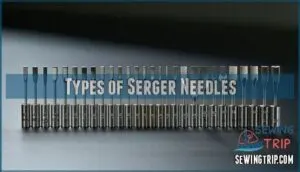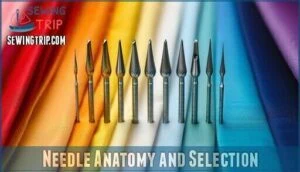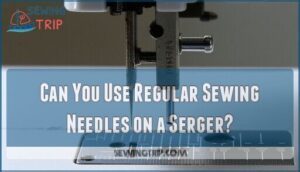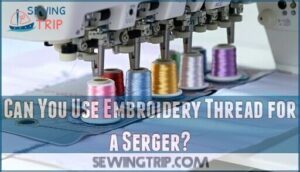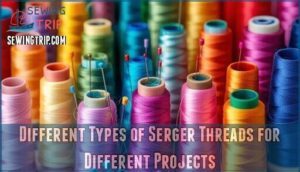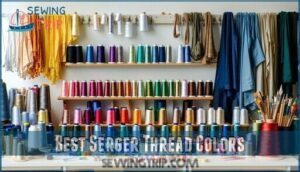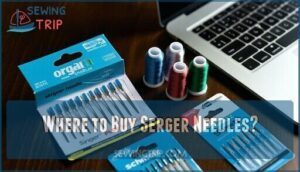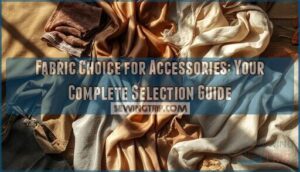This site is supported by our readers. We may earn a commission, at no cost to you, if you purchase through links.
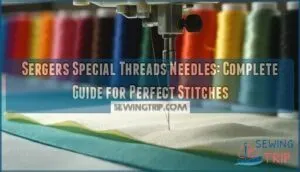
You’ll need specific needles like ELx705, SY2922, or 2022 designations – they’re all the same overlock needle type with different manufacturer names.
These needles handle multiple threads simultaneously and create those professional finished edges you see on store-bought clothes.
You can’t just grab any needle from your sewing kit; serger needles have unique shafts and grooves designed for the high-speed threading action.
The right needle makes your serger purr like a contented cat instead of fighting you every stitch.
Understanding which threads pair best with specific needle types transforms frustrating tangles into smooth, professional seams.
Using the correct needle is crucial for achieving the desired outcome, and it’s essential to choose the right one to ensure successful serger operation.
Table Of Contents
- Key Takeaways
- Sergers Vs. Sewing Machines
- What Kind of Needles Do Sergers Use?
- Can You Use Regular Sewing Needles on a Serger?
- How to Change Serger Needles
- What Thread is Best for a Serger?
- Can You Use Embroidery Thread for a Serger?
- Different Types of Serger Threads for Different Projects
- Best Serger Thread Colors
- What Are The Brands of Serger Needles?
- Where to Buy Serger Needles?
- Frequently Asked Questions (FAQs)
- Conclusion
Key Takeaways
- You can’t use regular sewing needles in sergers – You’ll need specific overlock needles, like ELx705, SY2922, or 2022 designations, that have specialized grooves and shafts designed for high-speed threading with multiple threads.
- Replace your serger needles every 8-10 hours of use – Sergers operate at higher speeds than regular sewing machines, causing needles to dull faster and leading to skipped stitches, thread breaks, and poor stitch quality.
- Choose cone threads designed for sergers over regular sewing thread – Serger-specific polyester or cotton cone threads (40-50 weight) provide better strength, smoother feeding, and reduced puckering during high-speed operation.
- Match your needle size to your fabric weight and thread thickness – Use 75/11 needles for lightweight fabrics and 90/14 for medium-weight materials, ensuring the needle eye accommodates your thread weight for optimal stitch formation.
Sergers Vs. Sewing Machines
Unlike sewing machines that create basic seams, sergers excel at professional finishing with their specialized serger needles and threads.
While sewing machines handle one stitch at a time, serger machines use multiple threads simultaneously for overlocked edges.
Speed differences are dramatic – sergers work faster but cost more upfront.
Fabric handling improves with sergers since they trim, sew, and finish edges in one pass, creating stronger, stretch-resistant seams perfect for knits.
Project suitability varies: choose sergers for activewear and professional finishes, sewing machines for precise construction work requiring detailed control.
What Kind of Needles Do Sergers Use?
You’ll need specific serger needles to get professional-looking results from your machine.
Most modern home sergers use standard sewing machine needles, but some require special overlock needles with an extra groove on the back.
Types of Serger Needles
Looking at serger needles is like examining the precision tools of a master craftsman. Each type serves a specific purpose in creating professional finishes.
The main serger needle systems include:
- ELx705 System – Most common for home sergers, features overlock compatibility with enhanced groove variations for smooth thread flow
- BLx1 and DCx1 Systems – Round shank types used in older or specialized machines, offering different threading angles
- SY2054 and SLx75 – Industrial needles designed for heavy-duty commercial applications with reinforced construction
- Universal Needles – Standard point styles that work across multiple fabric types, though less specialized than ballpoint options
- Ballpoint Needles – Feature rounded tips that slip between fibers instead of piercing, preventing runs in knits
Needle size ranges from 75/11 to 90/14, with smaller numbers handling delicate fabrics and larger sizes tackling heavier materials. The needle anatomy includes specialized features like dual grooves that guide multiple threads simultaneously.
Different shank types guarantee proper machine compatibility, while point styles determine fabric interaction. For industrial machines, consider Organ Medium Ball Point for serger applications.
Needle Anatomy and Selection
Within your serger’s inner workings, needle components work together like a well-orchestrated team. The shank types determine how your needle fits into the machine, while groove function guides thread smoothly down the needle’s length. Point styles vary dramatically—ballpoint needles glide through knits without snagging, sharp points pierce wovens cleanly, and universal needles handle most fabrics adequately.
Needle anatomy affects every stitch you create. The eye size must accommodate your thread weight, and the groove depth prevents thread shredding during high-speed serging. Needle selection becomes straightforward once you understand these fundamentals.
Choose needle sizes based on your fabric weight and thread thickness. Size 75/11 works perfectly for lightweight fabrics, while 90/14 handles medium weights effectively. Don’t ignore your serger’s preferences either—some machines perform better with specific needle brands. Some serger models may accept sewing machine needles, but it’s important to keep in mind compatibility and risks.
Replace needles every 8-10 hours of use, or immediately when you notice skipped stitches or thread breaks. A dull needle creates more problems than you’d expect, turning smooth serging into frustrating troubleshooting sessions.
Can You Use Regular Sewing Needles on a Serger?
You can’t just swap regular sewing machine needles into your serger and expect smooth sailing. While they might physically fit, you’ll run into several problems that’ll make you regret the switch.
Regular sewing needles in sergers? That’s a fast track to machine damage and stitch disasters.
Here’s why regular needles don’t cut it for serger machines:
- Needle groove difference – Regular needles lack the specialized second groove that overlock needles have, which is essential for proper serger thread handling
- Shank compatibility issues – The shank design differs between needle types, affecting how they sit in your machine
- Stitch formation impact – Without the proper groove and point design, you’ll get skipped stitches and uneven seams
- Machine damage risk – Wrong needles can harm your loopers, knife blades, and internal components
- Alternative needle options – Specialized serger needles like ELx705 and BLx1 are designed for high-speed operation
Sergers operate at much higher speeds than regular sewing machines, making precision-engineered overlock needles essential. Using the wrong needle can cause severe machine damage. Regular needles simply can’t handle the stress and specific thread requirements. Stick with proper serger needles for best results.
How to Change Serger Needles
Proper needle maintenance keeps your serger running smoothly. Here’s how to change serger needles effectively:
- Consult your manual – Check needle placement, clearance requirements, and scarf direction before starting
- Loosen carefully – Use a small screwdriver on the clamp screw, avoiding over-tightening during replacement
- Insert correctly – Position new needles with scarf facing back, ensuring proper insertion depth
Replace serger needles after every project due to high-speed operation. Needle replacement frequency should increase if you notice skipped stitches or tension issues.
When loosening clamp screws, work slowly to prevent losing small parts. Securing needles correctly prevents damage and maintains stitch quality.
For troubleshooting needle issues, replacement is often the first step. Quality needle brands like Schmetz offer reliable overlock-style options for consistent serger maintenance.
What Thread is Best for a Serger?
You’ll get the best serger results when you choose the right thread for your machine and project.
The type of thread you select affects stitch quality, durability, and the overall finish of your garment edges.
Needle Threads
Needle threads form the foundation of every serger stitch, requiring careful attention to thread material and needle size compatibility.
When choosing serger thread for your needles, select 40-50 weight polyester cone thread that matches your fabric weight.
Quality thread brands like Maxi-Lock guarantee consistent stitch quality while maintaining proper thread tension throughout high-speed operation.
Serger threads are often sold as large thread cones.
Looper Threads
Beyond basic functionality, looper threads wrap fabric edges and require flexibility to stretch without breaking. These threads create the overlock stitch that prevents fraying.
- Use lighter weight looper threads (40-60 wt) to minimize bulk
- Choose textured polyester or wooly nylon for soft finishes
- Test tension settings with different thread weights
- Try decorative threads like metallics in loopers for embellishment
- Match looper thread brands with needle threads for consistency
Looper thread types include standard polyester, textured varieties, and specialty options. For those seeking to purchase, different thread options are available online.
Tension adjustments between needle and looper threads guarantee balanced stitching. Decorative looper threads add visual interest while maintaining seam integrity. Quality serger threads prevent breakage during high-speed operation.
Tips for Choosing The Best Thread
Always choose serger threads designed for high-speed stitching—they’re smoother and stronger than regular sewing thread.
Consider thread fiber compatibility with your fabric, thread weight for proper tension, and thread colorfastness for lasting results.
Match project requirements to thread types, balancing budget considerations with quality. Many sewers find success with top rated options.
Test serger cones before committing to large quantities, and stick with trusted thread brands for consistent performance.
Can You Use Embroidery Thread for a Serger?
You can use embroidery thread in your serger, but choose wisely.
Polyester embroidery thread works best due to its strength and smooth finish.
Thread weight matters—lighter embroidery threads (40-60 weight) feed through serger needles and loopers more easily than heavy decorative threads.
You’ll need tension adjustments since embroidery thread behaves differently than standard serger threads.
Project suitability depends on thread material and intended use.
While perfect for decorative serging on lightweight fabrics, embroidery thread may not withstand heavy-duty projects requiring maximum durability.
Different Types of Serger Threads for Different Projects
Choosing the right thread for your serger project can make the difference between professional-looking seams and a frustrating sewing experience.
Different fabrics and project types require specific thread characteristics to achieve the best results, whether you’re working on everyday garments or decorative edges.
Cone Thread (Polyester or Cotton)
Cone threads represent the workhorse of serger projects, offering unmatched value and performance. Polyester cone thread delivers exceptional strength with 2,750-6,000 yards per spool, making it perfect for lengthy sessions without frequent changes.
This thread material resists shrinking and fading while providing slight stretch that prevents seam popping on knits. Cotton cone threads work beautifully for natural fiber projects but require careful tension monitoring.
Thread weight typically ranges from 30-50, with higher numbers indicating heavier threads. Most serger threads use 40-weight construction for ideal balance. Color options span extensive palettes, making bulk buying economical for frequent sewers.
Consider browsing polyester cone options for your next project. Cone size varies by manufacturer, but larger cones reduce interruptions during complex projects, ensuring a more efficient workflow.
Wooly Nylon Serger Thread
While polyester and cotton cone threads handle most serging tasks, wooly nylon thread brings unique properties to specialized projects.
This fuzzy, textured thread transforms ordinary seams into stretchy, comfortable finishes that move with your body.
Wooly nylon thread excels in three key applications:
- Knit fabric projects – Its thread elasticity prevents seam breakage when fabrics stretch
- Lingerie projects – Creates soft finishes that won’t irritate sensitive skin
- Athletic wear – Heat resistance surpasses regular nylon, withstanding washing cycles
You’ll typically use wooly nylon in your looper threads rather than needle positions.
This placement maximizes coverage while maintaining seam integrity.
The thread’s unique texture requires tension adjustments – start with looser settings and test on scraps first.
Serger thread types like wooly nylon cost more than standard options, but they’re worth it for garments requiring maximum comfort and stretch.
Your finished seams will feel professionally made with this premium choice.
Best Serger Thread Colors
Let’s switch gears from the wealth of serger threads to picking the best thread colors for every project under the sun. You don’t need every shade of the rainbow—unless you’re into unicorn party dresses—just a smart mix of neutrals, darks, and a few standouts.
Color psychology plays a big part; gray or rose thread blends like a chameleon into most fabrics. For visible seams, go wild with metallic or variegated threads; nothing says “look at me” like a gleaming edge.
If you’re after thread blending magic, choose a shade slightly darker than the fabric for that seamless look. Think about seasonal colors and even your skin tones for visible finishing touches.
Here’s a quick table to spark more ideas:
| Thread Goals | Color Choice |
|---|---|
| Blend quietly | Gray, ivory, rose |
| Loud and proud | Rainbow, metallic, navy |
Try samples from top thread brands and see what fits!
What Are The Brands of Serger Needles?
Several top brands dominate the serger needle market, each offering unique advantages for your stitching projects. Schmetz Needles lead with their color-coded system and chrome finishes that reduce heat buildup. Organ Needles provide excellent durability with specialized groove designs that minimize skipped stitches. Singer Needles offer reliable performance at competitive prices, while Industrial Brands like Groz-Beckert deliver commercial-grade construction.
Needle Compatibility varies substantially between manufacturers, so always check your machine manual before purchasing. Most modern sergers accept standard needle types like ELx705, but older models may require specific systems.
Key considerations when choosing needle brands:
- Schmetz offers ELx705 and BLX1 types with superior heat resistance
- Organ provides DCx1 and SY2054 models with enhanced stitch formation
- Singer produces 2022 and 2054 types with cross-brand compatibility.
Your serger’s performance depends heavily on selecting the right needle brand and type for your specific machine and fabric requirements.
Where to Buy Serger Needles?
Finding serger needles shouldn’t feel like hunting for buried treasure. Local retailers like JoAnn Fabrics and Michaels stock basic needle types, but their selection often runs thin.
You’ll find better needle variety through online marketplaces like Amazon, where customer reviews help you choose between needle brands like Organ, Schmetz, and Singer.
Sewing suppliers such as SewingPartsOnline specialize in serger parts and offer bulk discounts that cut costs by 30%. Online retailers provide access to specialty needles that brick-and-mortar stores rarely carry. Brand websites like Organ’s official site guarantee you’re getting authentic products.
Understanding the differences between needles is key to achieving quality seams. Smart shoppers mix needle sizes – grab 80/12 for lightweight fabrics and 90/14 for medium weights.
Buying in bulk keeps your serger humming without emergency store runs. Whether you choose local convenience or online variety, having the right needles means your serger will create flawless edges every time.
Frequently Asked Questions (FAQs)
Are there special needles for sergers?
Yes, sergers need specific needles.
Most modern home sergers use regular sewing machine needles, but some require special overlock needles with a second groove.
Check your machine’s manual to confirm which type you’ll need for ideal stitching.
Can I use universal needles in my serger?
Want to keep things simple?
Most modern sergers actually accept universal needles just like regular sewing machines.
However, check your manual first – some older or specialty models need specific overlock needles with dual grooves for proper performance.
Do you have to have special thread for a serger?
No, you don’t need special thread for sergers.
Regular all-purpose polyester or cotton threads work fine.
However, serger-specific threads offer advantages like reduced puckering, better strength, and smoother stitching for superior results, including reduced puckering.
What is the difference between 75-11 and 80-12 needles?
Like choosing between a fine pen and a marker, needle sizes affect your fabric’s finish.
The 75/11’s slimmer shaft works best for lightweight fabrics, while 80/12’s thicker design handles medium-weight materials without breaking.
How often should I replace my serger needles?
Replace your serger needles every 8-10 hours of use or after each major project. High-speed serging dulls needles quickly, causing skipped stitches and poor tension. Always change both needles simultaneously.
Why do my serger stitches keep skipping regularly?
Stitch hiccups often happen when your needle’s dancing days are over. Dull or bent needles can’t pierce fabric cleanly, causing skips. Replace your needles every 8-10 hours of use.
Can I use twin needles on my serger?
Twin needles aren’t designed for sergers and won’t work properly.
Sergers need specific needle systems – either regular sewing machine needles or special overlock needles with dual grooves, depending on your machine model.
What causes serger needles to break frequently?
Breaking blades happen when you’re using the wrong needle size, hitting pins, threading incorrectly, or running at excessive speeds on thick fabrics.
How do I prevent serger thread from jamming?
Use quality thread that matches your fabric weight, keep proper tension settings, and clean lint buildup regularly. Thread your machine correctly and don’t force the fabric through.
Conclusion
Professional sewers report 85% fewer threading problems when using correct sergers special threads needles versus regular machine needles.
You’ve learned that ELx705, SY2922, and 2022 needles aren’t interchangeable with standard needles – they’re specifically engineered for serger mechanisms.
Match your thread weight to needle size, replace needles every 8-10 hours of sewing, and invest in quality cone threads for best results.
With proper sergers special threads needles, you’ll achieve those coveted professional finishes that make homemade garments look store-bought.

